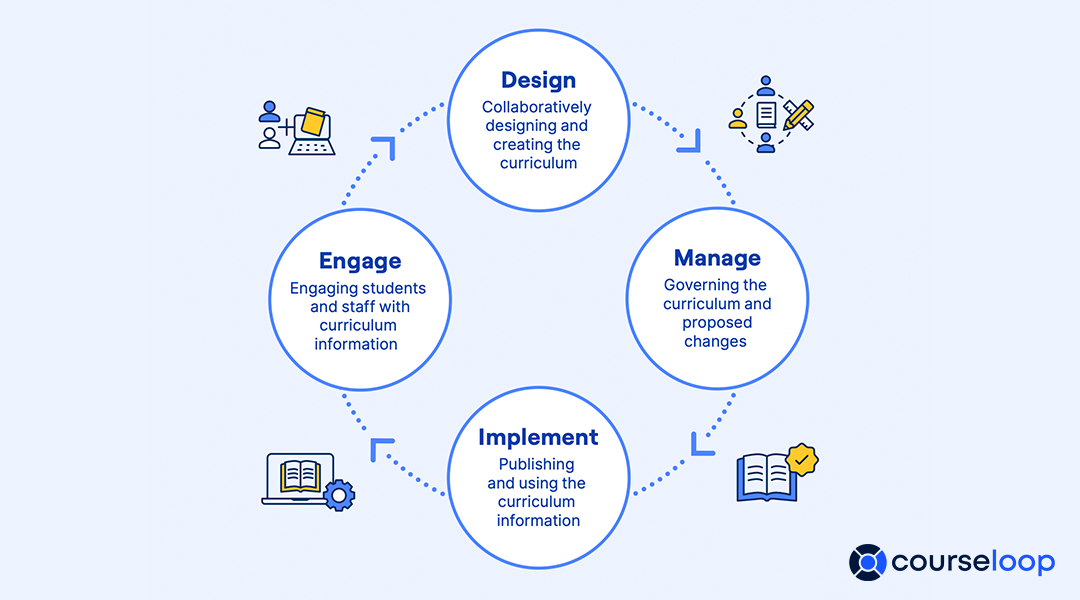
Share
Overcoming common curriculum management challenges in Higher Ed
Across the board in higher education, enrolment and retention are more important than ever. The state of education post-COVID-19, the rise of digital transformation, and changing student demands all contribute to these shifts; to stay ahead of the curve, institutions must consider how their academic offerings fit within this new world.
Just as an institution’s curricular offerings – their programs, courses, and units – can vary per country, so can their definitions for what constitutes “curriculum”.
In this blog, we’ll look at these different ways of considering “curriculum” as well as a common business model used to define “curriculum management”. By understanding the pain points that many institutions share regardless of geography, it’s easy to see how robust curriculum management systems can help universities overcome challenges.
Defining curriculum in various geographies
“In an environment seen as increasingly more complex and commercial, the term curriculum continues to be used in differing or undefined ways.”
Curriculum in higher education: Confusion, complexity, and currency
The definition of “curriculum” can vary, depending on who you’re talking to. Researchers around the world have spent decades devoting efforts to finding common ground, in large part because of the increasing internationalisation of higher education. With quality academic programming available digitally to virtually anyone in the world, some commonality would help with student understanding, transferability of credentials, and more.
In the United States, “curriculum” generally refers to the “taught curriculum” – that which is taught to and consumed by students. “Curriculum is the rational conversation between learner and coursework in higher education,” says Higher Education Curriculum: Traditional And Contemporary Perspectives.
However, in Australia and the United Kingdom, “curriculum” more often refers to the data components and information that is captured about the university’s taught offerings. For example, the UK’s Quality Assurance Agency (QAA) provides benchmark statements to universities to ensure that their curriculum delivers on the core competencies it seeks to help students achieve, but not on what is taught or how.
Overcoming key academic challenges: Accreditation, governance, and portability
Much like the definition of curriculum, the concept of curriculum management looks different in various geographies – and as such, has varying levels of impact.
For example, differing views of curriculum and curriculum management can impact portability of learning. The nature of work is changing, and employees are expected to maintain knowledge and skills across multiple fields and multi-faceted careers. In order to do so, they often have to dip back into education, whether that’s through micro-credentials or a more structured degree.
Regardless of learners’ choices, institutions need to recognise that learners will access lifelong learning from a variety of sources and that qualifications must now be designed to be portable across a range of education and employment contexts. This is where comprehensive curriculum management systems like CourseLoop can help institutions improve their curriculum design – and portability of learning – by leveraging efficient processes for proposing, approving, and managing credentials.
In another example, curriculum design and review in the United States is largely an internal process managed by the institution itself. A common sticking point within universities is a lack of or overly complicated process that can get bogged down. In the UK, institutions have the autonomy to design and develop their own programs of study, but programs are subject to required formal review by designated quality bodies (DQBs). While this improves the governance of programs, inadequate internal processes can again slow or stall curricular design and review, leaving institutions’ academic offerings to stagnate. In either case, the right curriculum management systems support the design, review, and improvement of curriculum, as well as streamline governance processes.
Curriculum management also impacts accreditation processes – which is perhaps one of the most striking differences country to country. In the UK and Australia, institutions must be accredited through the proper channels to be considered higher education providers and/or to offer academic programs and degrees. In the U.S., however, third-party accreditation is voluntary. Many universities do choose to opt in because accreditation signifies a program of quality to prospective students, allows institutions to receive federal student aid funds, and sometimes is a requirement if the institution intends for graduates to qualify for particular professional certification exams.
With a consolidated review process, institutions can more easily make evidence-based, continuous improvement to their academic offerings, supporting accreditation activities. Without effective processes in place, institutions run the risk of losing or not obtaining accreditation, which can have enormous consequences.
More unified ways of considering curriculum management
The Higher Education Reference Capability Model was created in an effort to unify the concept of curriculum and curriculum management – as well as other operational functions in higher education. Endorsed by CAUDIT in Australia, EDUCAUSE in the U.S., and UCISA in the UK, the model represents a global understanding of standard business architecture elements relevant to higher education.
The model’s definition of “curriculum management” is that it “designs and produces, or sources, structured learning activities such as courses, subjects, and units, and ensures the institution is able to deliver them.” The model’s understanding of curriculum management encompasses:
- Curriculum Planning researches the need, demand, and opportunities for educational products, such as courses and subjects, and decides which will be developed and offered.
- Curriculum Design produces complete specifications of structured learning activities such as courses, subjects, and units.
- Curriculum Production develops and provides resources needed to implement curriculum designs as deliverable educational products.
- Accreditation is the assessment of the institution’s curricula against the standards set by an accrediting authority.
- Offering Management plans and determines which of the institution’s educational products will be made available for students in any particular teaching session.
- Education Commercialisation redesigns or redevelops products for sale in markets for which the current designs are unsuited.
- Curriculum Improvement adjusts the curriculum in response to past or predicted curriculum performance.
- Curriculum Disestablishment manages the discontinuation of curriculum components.
While the Higher Education Business Capability Model is widely supported globally, it can be a more linear representation of higher education operations. Another way of viewing academic operations, especially curriculum management, is as a cyclical process.
At CourseLoop, we view curriculum management as a cycle underpinned by four domains of activity – design, manage, implement, and engage – whereby proposing, managing, updating, and publishing of curriculum should always be continual. We understand “curriculum management” as all of the touchpoints along the way from the creation of a learning experience; to governance, approval, and quality assurance; to the student’s experience of choosing what to study next.

Whether an institution views their curriculum management as a linear activity, a cyclical one, or something else, having a structured and systematic flow to the process is critical to overcoming common challenges, such as portability of learned skills, effective governance processes, and streamlined accreditation.
Today, digital curriculum management systems offer simple and effective tools to self-manage these processes to maximise impact and achieve institutional goals around academic offerings, student experience, and more.
How can a more comprehensive curriculum management system help institutions with their curricular offerings?
Regardless of how you define curriculum and where you are located, a comprehensive curriculum management system enables institutions to efficiently and effectively deliver within the “design” domain of the Higher Education Business Capability Model. A curriculum management system can solve challenges such as portability of credentials, redundant or outdated curriculum, and inefficient review processes, ultimately ensuring your institution is leveraging its academic offerings in a powerful way.
Essentially, curriculum management systems help institutions to:
- Eliminate redundancies and inefficiencies by adopting efficient data capture practices that reduce time spent on administration and manual data entry.
- Make evidence-based, continuous improvement to academic offerings for streamlined review and accreditation processes.
- Assure data integrity by leveraging a robust data model that pulls curriculum information from a single source of truth, eliminating data overlaps, duplications and inaccuracies.
- Increase flexibility in curricular design by allowing for quicker, easier launch of new programs.
- Better understand the full scope of program offerings and easily spot gaps through curriculum mapping, as well as evidence the assurance of learning outcomes.
- Redesign processes to better respond to digital transformation in higher education through dynamic workflow and collaboration tools.
- Positively impact the student experience through accurate study pathway recommendations for the achievement of qualification goals.
Robust curriculum management systems like CourseLoop can help your institution consolidate your curriculum review and accreditation processes, as well as leverage your academic offerings to impact enrolment, student success, and institutional goals.
CourseLoop is a true end-to-end curriculum management system with superior ease of integration and user experience. Discover the advanced solution that’s elevating student success worldwide.

